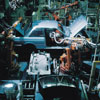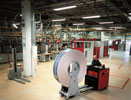

Network video is a security and productivity tool.
The use of network video as a business enabler has become widespread with the industrial sector, featuring among the most prolific users of network video solutions. Some of the most common uses of network video applications in the industrial sector include monitoring manufacturing lines, automation, warehouse and stock control, to name just a few.
The increasing number of ingenious applications that have been developed and rolled out in the industrial sector is proof that safety and efficiency at a production plant can be greatly enhanced through the 'virtual eyes'.
Safety, for example, can be enhanced at a rock crushing plant or chemical processing plant where there are health hazards for employees, by deploying network video solutions for remote monitoring of production processes. A network video system feeding images to the control room gives a plant worker the opportunity to check for machine malfunctions without the risk of inhaling dust or toxic fumes.
Another setting were network video renders itself extremely useful is the monitoring of production lines. In factories with automated production lines for instance, cameras observing a production line or factory robots can be programmed to send e-mail alerts if something unusual occurs. That way, the plant staff is relieved of the monotonous, yet very important and time-consuming task of watching out for machine malfunctions.
If a malfunction does occur and there are no service engineers in the area, a network video supported factory is still better off than one without network video solutions as the surveillance systems can be used to set up a virtual meeting and get technical support even if the sought technicians are located on the other side of the planet.
Even though it is sometimes negligible, the crime deterrence function of network cameras cannot be discounted in a manufacturing or factory setting. The accumulated costs of petty theft of raw materials entering and manufactured goods leaving a plant can add up to huge amounts over time. Network cameras work as a crime deterrent, as well as offering an easy way to check the efficiency of the loading and unloading methods being used.
Storage is another important part of factory life. Making sure a storage system works well – that goods can be accessed and are efficiently managed – can significantly affect the bottom line at a manufacturing plant. The fact that storage is often handled at remote sites, usually due to the lower cost, makes this another good place to install network video.

Making use of existing technology
In most high-tech production plants already using video solutions, even though it might be analogue video, all items that pass through the various stages of production are assigned unique barcode identifiers. Each assembled object is then given a thorough examination within the quality inspection area where any noticeable fault is recorded on an electronic form against the appropriate barcode.
Using an enhanced monitoring system, the video signal from each analogue camera on the assembly line can be fed to a network video server. This allows staff to view images from each camera from any workstation within the plant, not only from a dedicated monitor in the control room.
By complementing the quality inspection area with network cameras, the system can be modified to append a digital image of each inspected object, stamped with the time and serial number of each passing object. This information can be included in an electronic form within the database. The digital images can then be stored on the same hard drive within the control room, or they can optionally be downloaded to any other server over the network.
Digital images from the network cameras and video servers can be made accessible to the headquarters via the Internet. This allows the supervisor to inspect and study any serious faults at the plant, at any time.
KIA adds Axis
In 2006, Korean car manufacturer KIA Motors built a production plant near the city of Žilina in Slovakia. The communications infrastructure company Anect was assigned the task of designing an advanced IP-based infrastructure to perform multiple tasks such as server monitoring, security applications, IP TV and more. One of the applications in this infrastructure was a surveillance solution which gave KIA Motors the ability to monitor equipment and guarantee worker safety. The specifications included extreme reliability and safety, excellent video quality and advanced functionality such as easy remote control of the camera angles and data storage functionality.
Anect built a solution based on Axis network cameras installed directly on the underlying Cisco IP infrastructure.
The video feeds from the cameras are received at an onsite monitoring facility including 56 monitors and control through advanced technology. Innovations feature touch screen control of the Axis network cameras and seven Advantech servers that can record video streams from all cameras for 30 days.
The surveillance solution was built according to Cisco’s AVVID (Architecture for Voice Video and Integrated Data) architecture which resulted in a solution with high reliability and flexibility.
Absolute control
Today’s car manufacturing sites are among the most automated environments in the world. Computers controlling robots and other machinery today build cars faster and with much higher quality than what could be done by hand. But it is also a potentially dangerous environment where the automotive workers and specialists must be protected and operations need to be monitored in order to discover any problems before they cause disturbances to the production line.
In the KIA plant, each Axis camera works as its own server allowing it to operate autonomously and with high reliability. If one camera becomes unavailable, the others keep on working. By connecting a number of cameras into a central monitoring solution, KIA Motors can supervise the material/production flows, make sure safety regulations and procedures are followed and ensure the physical protection of the site.
The monitoring system is built on a unified communication infrastructure platform that, apart from data also enables voice and video signal transfer. It is this sharing of different data types in a single IP network that makes it possible for a customer to take full advantage of the IP technology.
The information is displayed on 56 smaller flat screen monitors (20-21”) and two large plasma screens – all from Samsung. In the current number of cameras and related equipment is also included the added site of Glovis, one of KIA’s suppliers, which opened up its own site next to KIA Motors.
For more information contact Roy Alves, country manager, Axis Communications, +27 (0)11 548 6780, [email protected]
| Tel: | +27 11 548 6780 |
| Email: | [email protected] |
| www: | www.axis.com |
| Articles: | More information and articles about Axis Communications SA |

© Technews Publishing (Pty) Ltd. | All Rights Reserved.